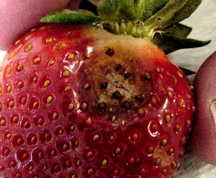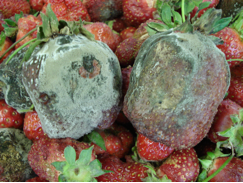
Anthracnose Fruit Rot of Strawberry
Fruit rots in strawberry can cause significant losses if not recognized early and controlled. The use of good cultural practices such as keeping fields weed-free and promoting good drainage, long crop rotations, and preventative fungicide applications are critical.
Pathogens such as anthracnose, gray mold (Botrytis), and leather rot (Phytophthora) can become systemic problems in strawberry plantings once established. All three fungal diseases are soil-borne and once in fields can be difficult to manage over the lifetime of the planting.
The use of mulch (matted rows) to prevent/reduce soil splashing and keeping fruit from coming into direct contact with the soil surface can be beneficial in organic production systems where conventional fungicides cannot be used. Use of long crop rotations and staying away from areas of the farm with known instances of any of these pathogens is also important. Remember that same species of Colletotrichum that causes fruit rot in pepper and other crops can also infect strawberry.

